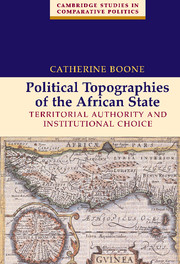Book contents
- Frontmatter
- Contents
- List of Maps, Tables, and Figures
- Preface and Acknowledgments
- 1 INTRODUCTION
- 2 MAPPING POLITICAL TOPOGRAPHY IN AFRICA
- 3 UNEVEN INSTITUTIONAL TOPOGRAPHY WITHIN ONE STATE
- 4 TAXING RICH PEASANTS: REGIME IDEOLOGY AS STRATEGY
- 5 THE GEOPOLITICS OF LATE DEVELOPMENT
- 6 CONCLUSION
- Appendix: A Note on Sources, Evidence, and Measurement
- References
- Index
- Cambridge Studies in Comparative Politics
5 - THE GEOPOLITICS OF LATE DEVELOPMENT
Published online by Cambridge University Press: 26 December 2009
- Frontmatter
- Contents
- List of Maps, Tables, and Figures
- Preface and Acknowledgments
- 1 INTRODUCTION
- 2 MAPPING POLITICAL TOPOGRAPHY IN AFRICA
- 3 UNEVEN INSTITUTIONAL TOPOGRAPHY WITHIN ONE STATE
- 4 TAXING RICH PEASANTS: REGIME IDEOLOGY AS STRATEGY
- 5 THE GEOPOLITICS OF LATE DEVELOPMENT
- 6 CONCLUSION
- Appendix: A Note on Sources, Evidence, and Measurement
- References
- Index
- Cambridge Studies in Comparative Politics
Summary
Expanding the scope of commercial agriculture was integral to state formation in the postcolonial period, for “development” could extend the reach of the state and strengthen a regime's grip on new regions (and new producers). In the best of circumstances it also helped fill state coffers with export and tax revenues. Viewing postcolonial development through statist lenses, it is easy to miss how political – and how constrained – African rulers' choices really were about where, when, and how to promote structural transformation in rural social relations and modes of production. Rulers were constrained by their rural allies' demands and refusals, by fears of the political consequences of rural socioeconomic change, and by possibilities and limits to change inherent in indigenous modes of agricultural production. The endogenous theory of institutional choice focuses attention on these geopolitical factors. In so doing it helps measure the considerable extent to which institutional and market structures of African economies have been shaped by the rural societies that central rulers have sought to tax and govern. Leaders who now seek to defy or willfully transform these constaints continue to do so at considerable political risk and cost.
This chapter focuses on two regions that were economically peripheral at the time of independence: the Senegal River Valley, which divides Senegal and Mauritania (and thus constitutes Senegal's northern border region), and the Korhogo region, which is the center of gravity of Côte d'Ivoire's northern half.
- Type
- Chapter
- Information
- Political Topographies of the African StateTerritorial Authority and Institutional Choice, pp. 240 - 317Publisher: Cambridge University PressPrint publication year: 2003



